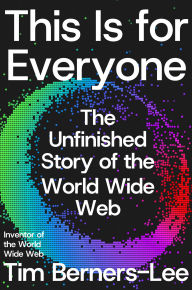Inventing the World Wide Web: A Guest Post by Sir Tim Berners Lee
In his new memoir, the inventor of the World Wide Web reveals how he invented the web – and how to fix it. Read on for an exclusive essay from Sir Tim Berners-Lee on why he wrote This Is for Everyone.
This Is for Everyone: The Unfinished Story of the World Wide Web
This Is for Everyone: The Unfinished Story of the World Wide Web
In Stock Online
Hardcover $30.00
The inventor of the World Wide Web explores his vision’s promise—and how it can be redeemed for the future.
The inventor of the World Wide Web explores his vision’s promise—and how it can be redeemed for the future.
I was thirty-four years old when I first presented the idea for the World Wide Web. I had never been to Silicon Valley, had no connection to venture capital, and had no track record as an inventor.
But in 1988, I was seized by the idea of combining the internet with hypertext, which takes an ordinary document and brings it to life by adding ‘links’. My idea was that by giving users a simpler way to navigate the internet, millions of people would start linking, sharing, and following across the planet. And if you could put anything on it, then after a while, it would have everything on it. Because my idea could connect so many people, systems, and countries, I called it the World Wide Web. But when I described this vision to people, most of them seemed to regard me as a little eccentric.
This is the unlikely story of how I built the first web page, the first web browser, and the first web server, all on a single computer in a small room at CERN in Geneva.
As the web grew the only way forward, I realized, was to donate the intellectual property behind the web to the public domain. For the web to flourish it had to be free. In 1993, I successfully lobbied CERN to donate the World Wide Web to the public to ensure a web free and accessible to all.
So much has happened over the time of the web. Other communications technologies have come and gone, but the web has only grown. It has become a kind of default layer for daily life; a sprawling network of links now connecting most of the planet’s population.
From the initial creative outpouring of blogs to the rise of the social media behemoths to the AI-powered world unfolding. The web has been the foundation for these developing technologies. That was part of the motivation for writing This Is for Everyone. The AI wave is one of our biggest opportunities yet and promises to deliver a great deal of value for humankind. But experience suggests we also have to be careful; the development and use of new technologies can threaten dystopian outcomes.
Technologies should be built to empower individuals. That’s what the web initially did, allowing an influx of creativity and connectivity. Yet expectations of privacy, of dignity, of digital sovereignty, have been corroded in the quest for profit. In authoritarian societies, the web has been used as a tool for social domination and control.
The positive task at hand now is to build a new, better web where people are empowered again. This book details Solid – a protocol I developed with my team at MIT that returns us to my vision for a pro-human web. A web that re-empowers individuals and brings back the values of creativity, collaboration and passion.
It is up to us to determine what we want the web to be. We can still build the future we want. There’s still time to build machines that serve the human, rather than the other way round. There’s still time to forge connections between people and use technology to fight for our rights. There’s still time to recapture our data sovereignty. There’s still time to build community. There’s still time for the individual, for the child, for the parent, for the elder, for the West, for the East, for the developing world, to come together to build technology to promote the dignity of our fragile species on this isolated globe.
We can do it – all of us, everyone, together.
